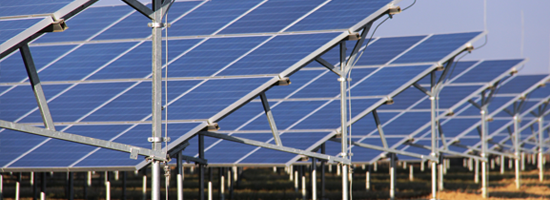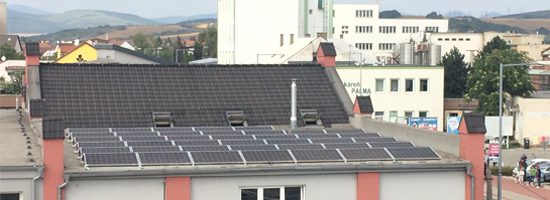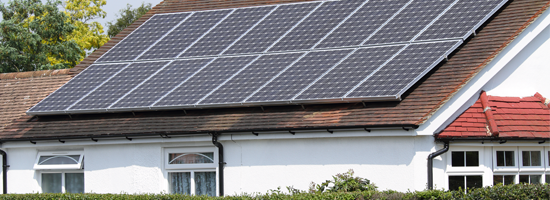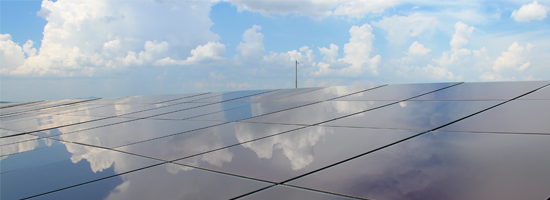Photovoltaics

The sun is one of the most easily available and cleanest renewable energy sources. This is one of the reasons why photovoltaics is an area whose development has made the most progress in the last decade.
Nowadays, the conversion of solar energy to electric energy is based on network, hybrid and island technologies with the possibility of ensuring an energy backup.
Our company deals with the construction, operation and servicing of all types of photovoltaic power plants ranging from a few kilowatts to hundreds of megawatts, in a single-phase and three-phase version, for both roof and field applications.
The term photovoltaics means a simple process of converting solar energy to electric energy through electrochemical processes. As early as in 1830, Antoine César Becquerel observed the photovoltaic effect, but the first photovoltaic cell was created only in 1950, prompting a new boom in photovoltaic sources.
The attractiveness of photovoltaic solutions results primarily from partial or total independence from electricity supply from the distribution network, because the sun is a sustainable and environmentally friendly resource whose energy may be used efficiently by everybody.
Photovoltaic power plants using the photovoltaic effect normally convert the produced energy in three ways:
On-grid – network systems
The most frequent and simplest solution for the transformation and distribution of produced electric energy from solar radiation is the standard interconnection of photovoltaic panels and the distribution network via an inverter. The photovoltaic inverter directly converts the direct power obtained from the sun and photovoltaic panels to alternating power. The electrical parameters at the output of the inverter depend on the parameters of the distribution network. Thus, the inverter is not capable of operating without the presence of network voltage on alternating side terminals.
This type of source can be used for the purposes of partial or total coverage of one’s own consumption (domestic appliances, industrial facilities) or for the sale of energy to energy companies.
The network technology is used by default for the implementation of photovoltaic farms and it is also a popular and affordable solution also for roof applications.
The construction of photovoltaic farms is a complex project requiring experience in the design of the solution (selection and orientation of the terrain, the method of processing the direct power, …), the preparation of design documentation, the implementation itself, the connection to the distribution system, the operation of the power plant, its servicing and maintenance. The power output of such power plants ranges from hundreds of kilowatts to tens of megawatts; for the purpose of construction, small kilowatt inverters (decentralized solution), but more often three-phase inverters (hundreds of kilowatts) are used, referred to as centralized solution.
The project of the photovoltaic power plant network system for the roof of residential or commercial buildings is simpler but to achieve maximum efficiency it requires good knowledge of the behavior of photovoltaic panels during year-round operation. The power output of the inverter ranges from a few to tens of kilowatts, and since the energy produced is not storable in the network inverter itself, its power output produced should be less than the total household consumption or consumption of the operation. As a matter of fact, the surpluses that arise are distributed to the distribution network, and nowadays such energy supply is not being bought (in some cases, it is even undesirable), so that it represents just an economic loss for the power plant operator.
The advantages of implementing an on-grid-network system are the ease of its implementation, a greater direct efficiency, a direct connection to the network node (the size of the inverter is not dependent on the load size) as well as lower investment costs. The disadvantage is dependence on the presence of the distribution network and, in many cases, the necessary management of the consumption of the energy produced.
Off-grid – island systems
Island systems are often used in operations that are located far from standard electricity sources or in applications where independent power supply is required.
The principle of island photovoltaic systems is based on the supply of electricity obtained from the sun and processed so as to provide the required nominal electrical parameters of the appliances. The ability to independently generate the required voltage flow and current flow from the electric distribution network is a necessity for the operation of an island system. Since radiation from the sun is an unstable source of energy (clouds, fog, temperature, …) securing the stability of the electricity supply process is addressed in these island systems by means of energy accumulation in batteries. When electricity consumption is low or electricity supplies from the sun are high, this “excess” energy can be accumulated in batteries and can then be used when it is not possible to provide sufficient energy from the photovoltaic panels.
The island system set thus consists of three basic units: the charger (it transforms electric energy from the sun to direct power suitable for charging the batteries), the batteries (they maintain the energy stability of the system and ensure independence from any energy source), the inverter (converts the direct power from the batteries to alternating power with the required parameters). The system can supply both alternating and direct power (from batteries) and the off-grid inverter enables to connect other alternative sources, such as a wind turbine or a diesel generator set, to its inputs to support the power generation.
A disadvantage is the technologically more demanding and expensive installation, the energy dependence on the size of the power batteries and the inverter limiting the size of the connected load. The most important disadvantage is the switch-off of power supply for appliances if the production is weak and there is no energy reserve. The main advantage of island systems is their independence from the distribution network and the independence of the presence of the load from the power generation.
Hybrid systems
The hybrid system is actually an island system with the possibility of being connected to the distribution network. This yields a combination of the advantages of island systems (power supply independently of the presence of the network, the possibility of storing surplus energy in batteries, the possibility of adding additional sources) and network systems (in the case of a lack of energy from photovoltaics, the ability of getting power supply from the distribution network). This creates an ideal source of energy for households, enabling them to create an alternative, independent source to the usual distribution network.
Like the island systems, this solution consists of a charger, a battery and an inverter. The inverter is capable of being connected to the distribution network and can intelligently manage the take-off between the network and photovoltaics or, where applicable, another alternative source.
The disadvantage of these systems is their higher purchase price (which significantly depends not only on the price of panels, but also on the price of batteries), as well as a more demanding and more extensive installation. A hybrid solution for the output of the power of a photovoltaic power plant can be implemented in the form of a few kilowatts up to tens of kilowatts in single-phase and three-phase version.
Applications

/// Energy sector
Photovoltaic farms from tens of kWp to tens of MWp.

/// Industry, commercial and public sector
Photovoltaics on roofs of industrial, commercial and public buildings of up to 100 kWp.

/// Residential buildings
Photovoltaics on roofs of family houses from hundreds of Wp to a few kWp.

/// Infrastructure
Photovoltaics on parking lots from a few to tens of kWp.
References
Our company has completed more than 100 projects with a total installed capacity of over 40 MWp.











Contact us
If you would like us to prepare for you a quotation or if you would like to know more about the solutions offered, do not hesitate to contact us.

